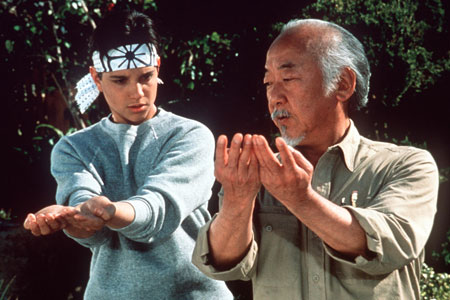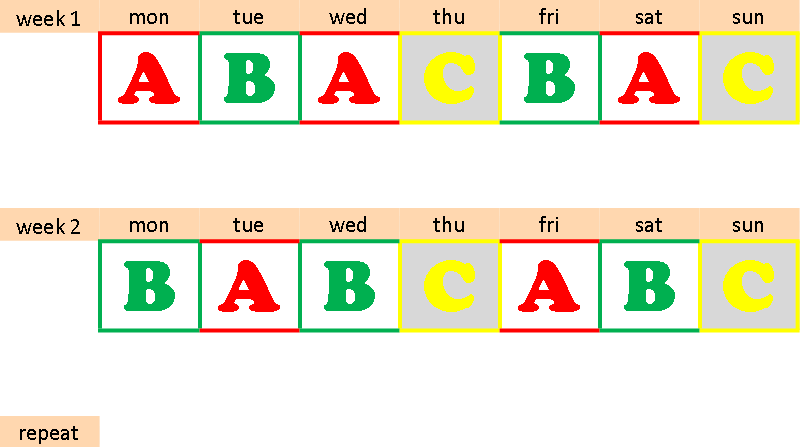 I first wrote The ABC Routine in the mid-90’s. It is meant to be a quick and easy reference guide for anybody just returning to the gym for the first time in years, or interested in getting started with some light weight training for the first time ever. The ABC Routine is an excellent general weight training program that will help you “get your feet wet”. However, learning how to weight train properly from a book or article is not a good replacement for good personal training instruction from a qualified coach or expert personal trainer.
I first wrote The ABC Routine in the mid-90’s. It is meant to be a quick and easy reference guide for anybody just returning to the gym for the first time in years, or interested in getting started with some light weight training for the first time ever. The ABC Routine is an excellent general weight training program that will help you “get your feet wet”. However, learning how to weight train properly from a book or article is not a good replacement for good personal training instruction from a qualified coach or expert personal trainer.
Most people reading this have likely seen the movie, “The Karate Kid”, either the newer one with Will Smith’s son, or the original with Pat Morita that I will talk about here. The formula is the same in both films. In the beginning of the movie, Daniel attempts to practice his Karate, taking lessons from a book, but it is not until Mr Myagi adopts him as a student that Daniel’s Karate really begins to develop. Also, in the beginning of his learning process, Daniel questions the seemingly simple and pointless menial tasks Mr. Myagi (Pat Morita) instructs Daniel to perform, but we find out later that these tasks were not so pointless – they were laying the foundation for future learning. You may not yet have access to your own weight training Mr Myagi, expert personal trainer, or qualified coach, so, until then, consider using this ABC routine as a beginner’s guide.
 INSTRUCTIONS
INSTRUCTIONS
1) Pick 2 of the four exercises under each underlined heading. (You will perform 4 exercises total each workout day)
2) Perform 4-5 sets per exercise. (More sets may be required for practice and/or warming up)
3) Do 8-12 reps per set. (Challenge yourself… safely)
4) Use a repetition tempo of 4-1-1
(Lower the weight in 4 seconds, pause at the bottom (or top) of the range for 1 second, lift/raise the weight in 1 second).
5) Rest 1 minute or less between each set. (Stretching between sets is a good idea)
SUGGESTED SCHEDULE

WORKOUTS (see below)
WORKOUT A : “PUSH and PULL”
Push exercises*
- Flat bench Dumbbell press
- Incline bench Dumbbell press
- Decline bench Dumbbell press
- Seated Military Dumbbell press
Pull exercises*
- Bilateral (two handles) pull-downs
- Bilateral (two handles) seated cable row
- Standing Rope Rows from hi cable
- Standing Rope Rows from lo cable
WORKOUT B : “SQUATS and ABS”
Squat exercises*
- Bodyweight Squats
- Front Squats
- Back Squats
- Box Squats
Abdominal exercises*
- Decline Board Sit-ups
- Roman Chair Knee ups
- Bent knee crunches
- Hanging leg raises
CARDIO
Perform 20-30 minutes continuous activity on bike, elliptical, treadmill, jumping rope, or any combination of these options totaling 20-30 minutes.
Pro Tip:
Using an inexpensive sports watch with a built-in timer is an extremely convenient and productive way to time not only your rest time between sets, but also the duration of your set, also known as the “time under tension”. Using the guidelines detailed in The ABC Routine (above), a set of 10 reps should take exactly 60 seconds. Using a watch with a simple timer function
will help you immensely.
DISCLAIMER: This routine is followed at your own risk. This routine is not meant to replace the advice of a qualified coach or expert personal trainer. The information contained or implied here is not intended to diagnose or cure any specific illness or condition. Paul Newt, New Energy & Weight-loss Training Systems, EDGE 24 Hour Private Fitness, its employees, associates, and/or affiliated parties are in no way responsible or liable for any injuries, conditions, or maladies suffered as a result of the information given here. Always consult your physician before beginning any eating or exercise program.












